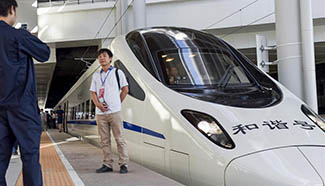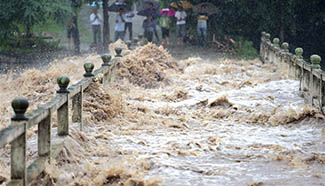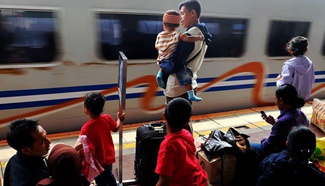
BEIJING, June 30, 2016 (Xinhua) -- File hoto taken on Sept. 28, 2014 shows a train running on the Nagqu section of the Qinghai-Tibet railway, southwest China's Tibet Autonomous Region. The Qinghai-Tibet Railway turns 10 on July 1, 2016. The 1,956-kilometer-long railway, which began service in July 2006, is the world's highest and longest plateau railroad and also the first railway connecting the Tibet Autonomous Region with other parts of China. Ecological protection measures taken during and after the construction of the railway have ensured it was built as "a green railway". Noting that environmental pollution has been brought under effective control, it said the alpine vegetation ecosystem has been effectively protected, the permafrost environment has been stable for years, the eco-function regions have been doing well and the plateau landscape remains intact. (Xinhua/Wang Song)
LHASA/XINING, July 1 (Xinhua) -- China's Qinghai-Tibet Railway, the world's highest rail system, marked its 10th anniversary on Friday.
The 1,956-km railway links Tibet with neighboring Qinghai Province. The system put an end to Tibet's inaccessibility when it opened on July 1, 2006.
At 10 a.m., a full Z323 train from the southwestern metropolis of Chongqing arrived at Lhasa Railway Station in the region's capital, where peak tourist season has begun.
"This is my first time in Tibet. I saw flocks of sheep and cattle as well as magnificent snow-covered mountains from the train windows," said Liao Xueyin, a tourist from southwest China's Sichuan Province.
Zhu Binyu, conductor of a Z917 train that left the northwestern city of Lanzhou for Lhasa on Friday, said she felt honored to be on duty for the 10th anniversary.
Zhu, 26, said the train crew will share a big cake with passengers to celebrate.
There were no high-profile official celebrations scheduled for Friday. Qinghai Post held a small ceremony on Friday morning at Xining Railway Station for a newly issued commemorative stamp.
"For us railway workers, the 10th anniversary is a glorious moment," said Lei Zengxiang, a veteran railway worker who bought a set of stamps.
The Qinghai-Tibet railway, which began construction in 2001, is the world's longest railway built on a plateau, with its highest point 5,072 meters above sea level.
Losang Jamcan, chairman of the regional government, said in an interview with Xinhua on Friday that Tibet will continue to expand its railway network until 2030. "By then, Tibet will be better connected with and opened up to the surrounding areas and South Asia," he said.
"Tibet is an important open area along the border. It is a key portal along the economic corridors of China, Bangladesh, India and Myanmar.
Jamcan said Tibet will build more transportation lines linking South Asia. Railway network will be extended to the Jilung, Yadong and Burang ports along the Chinese borders with India and Nepal, he said.
ROAD TO PROSPERITY
Wang Fuhai, a truck driver, still remembers the hardship of driving from Xining, capital of Qinghai, to Lhasa before the railway opened.
"Tibet was then a remote paradise. It could take half a month to drive there if there was heavy snow," said the 52-year-old driver, adding that each journey was a risky venture.
Now it only takes 22 hours to reach Lhasa from Xining by train, greatly lowering transportation costs. The railway currently transports 75 percent of freight in Tibet.
Before the railway opened, a chicken could cost as much as 110 yuan (16.5 U.S. dollars), and the purchasing power of 100 yuan in Tibet was equivalent to just 54 yuan in coastal areas, said He Gang, a researcher with the Tibet Regional Academy of Social Sciences.
"The price of soap has been cut in half to six yuan now, almost the same as in the inland regions," said Nyima Ngoezhub, who traveled by train in 2006 to Chengdu's Southwest University for Nationalities for college.
Shopping online has also been made easier now that packages can be sent by train, said Nyima Ngoezhub who currently works in Xigaze, the second-largest city in Tibet.
Tibet, with a population of about 3 million, topped the country in mobile payments in 2015, with 83 percent of online purchases in the region done through mobile phone. Tibetans' per capita online payments averaged 32,000 yuan in 2015, according to Alipay, the payment arm of Chinese e-commerce giant Alibaba Group.
"The Qinghai-Tibet railway broke the transportation bottleneck in Tibet's social and economic development," said He.
As of the end of May, 115 million passengers and 448 million tonnes of freight had been transported via the railway, driving an economic boom in the region over the past decade.
According to Tibetan government statistics, GDP surged from 25 billion yuan in 2005 to 102.6 billion yuan in 2015, with an annual growth rate of over 10 percent that led the country for years. The figures in Qinghai also rose, from 64 billion yuan in 2005 to 241.7 billion yuan in 2015.
Thanks to the railway, many hard-to-reach natural wonders such as Yarlung Zangbo River Grand Canyon and Mount Qomolangma are now accessible to visitors.
In 2015, 20.2 million tourists visited Tibet, 11 times more than before the railway opened. Tourism revenue last year exceeded 28 billion yuan, 15 times more than a decade ago.
Xi Yuxiu, who opened a small restaurant along the train line, is happy the peak tourism season is coming.
"It will be no problem earning 80,000 yuan in the summer," said Xi from Xiaozhuang Village in Huzhu Tu Autonomous County, Qinghai Province.
In addition to spurring growth in the plateau region, the Qinghai-Tibet railway has played a pivotal role in boosting trade with South Asia.
A Lanzhou-Xigaze-Kathmandu international freight line combining railway and road transport opened in May.
"The Qinghai-Tibet railway not only promotes the integration of the Tibetan economy with the whole country but is becoming a pivot point in China's economic ties with India and Nepal," said Sun Yongfu, an academician from the Chinese Academy of Engineering.
Tibet will add an extra 2,000 km of railways with total investment of 160 billion yuan in the next five years, according to the regional government.











